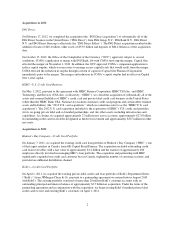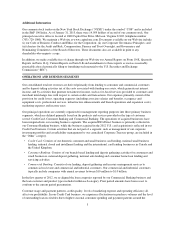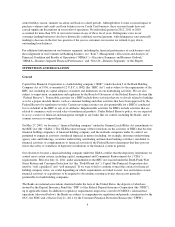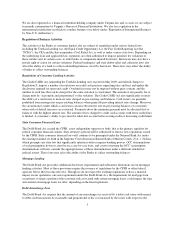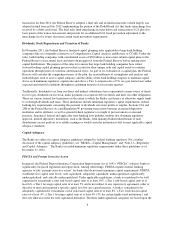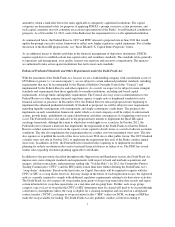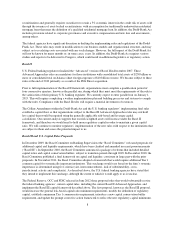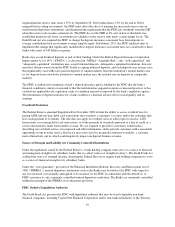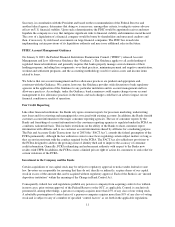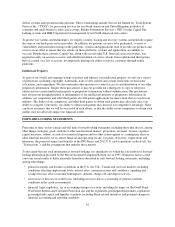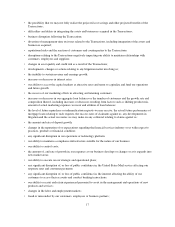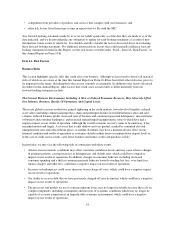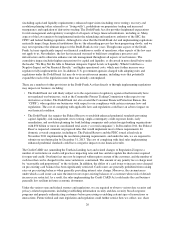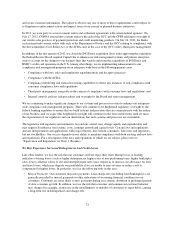Capital One 2012 Annual Report Download - page 30
Download and view the complete annual report
Please find page 30 of the 2012 Capital One annual report below. You can navigate through the pages in the report by either clicking on the pages listed below, or by using the keyword search tool below to find specific information within the annual report.Secretary, in consultation with the President and based on the recommendation of the Federal Reserve and
another federal agency, determines that doing so is necessary, among other criteria, to mitigate serious adverse
effects on U.S. financial stability. Upon such a determination, the FDIC would be appointed receiver and must
liquidate the company in a way that mitigates significant risks to financial stability and minimizes moral hazard.
The costs of a liquidation of a financial company would be borne by shareholders and unsecured creditors and
then, if necessary, by risk-based assessments on large financial companies. The FDIC has issued rules
implementing certain provisions of its liquidation authority and may issue additional rules in the future.
FFIEC Account Management Guidance
On January 8, 2003, the Federal Financial Institutions Examination Council (“FFIEC”) released Account
Management and Loss Allowance Guidance (the “Guidance”). The Guidance applies to all credit lending of
regulated financial institutions and generally requires that banks properly manage several elements of their
lending programs, including line assignments, over-limit practices, minimum payment and negative amortization,
workout and settlement programs, and the accounting methodology used for various assets and income items
related to loans.
We believe that our account management and loss allowance practices are prudent and appropriate and,
consistent with the Guidance. We caution, however, the Guidance provides wide discretion to bank regulatory
agencies in the application of the Guidance to any particular institution and its account management and loss
allowance practices. Accordingly, under the Guidance, bank examiners could require changes in our account
management or loss allowance practices in the future, and such changes could have an adverse impact on our
financial condition or results of operation.
Fair Credit Reporting
Like other financial institutions, the Banks rely upon consumer reports for prescreen marketing, underwriting
new loans and for reviewing and managing risks associated with existing accounts. In addition, the Banks furnish
customer account information to the major consumer reporting agencies. The use of consumer reports by the
Banks and furnishing of account information to the consumer reporting agencies is regulated under the FCRA on
a uniform, nationwide basis. This includes restrictions on the ability of the Banks to share consumer report
information with affiliates and to use customer account information shared by affiliates for a marketing purpose.
The Fair and Accurate Credit Transactions Act of 2003 (the “FACT Act”), extends the federal preemption of the
FCRA permanently, although the law authorizes states to enact laws regulating certain subject matters so long as
they are not inconsistent with the conduct required by the FCRA. The FACT Act also added new provisions to
the FCRA designed to address the growing crime of identity theft and to improve the accuracy of consumer
credit information. Generally, FCRA rulemaking and enforcement authority with respect to the Banks now
resides with CFPB. In addition, the FCRA creates a limited private right of action for consumers to seek relief for
certain violations of the FCRA.
Investment in the Company and the Banks
Certain acquisitions of our capital stock may be subject to regulatory approval or notice under federal or state
law. Investors are responsible for ensuring that they do not, directly or indirectly, acquire shares of our capital
stock in excess of the amount that can be acquired without regulatory approval. Each of the Banks is an “insured
depository institution” within the meaning of the Change in Bank Control Act.
Consequently, federal law and regulations prohibit any person or company from acquiring control of us without,
in most cases, prior written approval of the Federal Reserve or the OCC, as applicable. Control is conclusively
presumed if, among other things, a person or company acquires more than 25% of any class of our voting stock.
A rebuttable presumption of control arises if a person or company acquires more than 10% of any class of voting
stock and is subject to any of a number of specified “control factors” as set forth in the applicable regulations.
11



